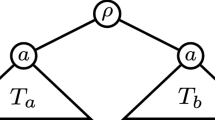Abstract
Information about the way of branching of dendritic arborizations may be obtained by comparing the frequency distributions of observed branching patterns with theoretical distributions based on well-defined growth models. Two models usually get much attention in geomorphological and (neuro)biological studies, viz. terminal growth and segmental growth. Formulae to construct the exact probability distributions for both growth models are presented. It is shown that ranking and lumping of the individual branching patterns enable the analysis of very large arborizations with relatively few data. The application of the Kolmogorov goodness-of-fit test for discrete distributions to the analysis is discussed.
Similar content being viewed by others
Literature
Berry, M. and P. M. Bradley. 1976. “The Application of Network Analysis to the Study of Branching Patterns of Large Dendritic Fields.”Brain Res.,109, 111–132.
—, T. Hollingworth, E. M. Anderson and R. M. Flinn. 1975. “Application of Newwork Analysis to the Study of the Branching Patterns of Dendritic Fieldss” InAdvances in Neurology, Ed. G. W. Kreutzberg, Vol. 12, pp. 217–245, New York: Raven Press.
— and D. Pymm. 1981. “Analysis of Neural Networks” InAdvances in Physiological Science Vol. 30.Neural Communications and Control, Eds. G. Szekely, E. Labos and S. Damjanovitch. 28th International Congress of Physiological Science. Budapest 1980. Budapest: Akadémiai Kiadó/Oxford: Pergamon Press, 1981.
Conover, W. J. 1972. “A Kolmogorov Goodness-of-Fit Test for Discontinuous Distributions”J. Am. statist. Ass. 67, 591–596.
Dacey, M. F. and W. C. Krumbein. 1976. “Three Growth Models For Stream Channel Networks”J. Geol.84, 153–163.
Harding, E. F. 1971. “The Probabilities of Rooted Tree-shapes Generated by Random Bifurcation”J. appl. Prob. 3, 44–77.
Horn, S. D. 1977. “Goodness-of-Fit Tests for Discrete Data: A Review and an Application to a Health Impairment Scale”.Biometrics,33, 237–248.
Scheidegger, A. E. 1967. “On the Topology of River Nets”.Water Resources Res.,3, 103–106.
Shreve, R. L. 1966. “Statistical Law of Stream Numbers”J. Geol. 74, 17–37.
Smart, J. S. 1969. “Topological Properties of Channel Networks”,Geol. Soc. Am. Bull. 80, 1757–1774.
Smit, G. J., H. B. M. Uylings and L. Veldmaat-Wansink. 1972. “The Branching Pattern in Dendrites of Cortical Neurons”Acta Morphol. Neerl. Scand. 9, 253–274.
Uylings, H. B. M., G. J. Smit and W. A. M. Veltman. 1975. “Ordering Methods in Quantitative Analysis of Branching Structures of Dendritic Trees”. InAdvances in Neurology, Ed. G. W. Kreutzberg, Vol. 12, pp. 247–254. New York: Raven Press.
Verwer, R. W. H. and J. Van Pelt. 1983. “A New Method for the Topological Analysis of Neuronal Tree Structures.”,J. Neurosci. Meth. (submitted).
Author information
Authors and Affiliations
Rights and permissions
About this article
Cite this article
van Pelt, J., Verwer, R.W.H. The exact probabilities of branching patterns under terminal and segmental growth hypotheses. Bltn Mathcal Biology 45, 269–285 (1983). https://doi.org/10.1007/BF02462361
Received:
Revised:
Issue Date:
DOI: https://doi.org/10.1007/BF02462361




